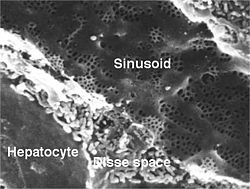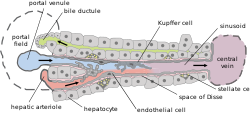
Back حيز محيط بالجيبانيات (طب) Arabic Disseho prostor Czech Disse-Raum German Espacio perisinusoidal de Disse Spanish ディッセ腔 Japanese Przestrzeń okołozatokowa Polish Espaço de Disse Portuguese Перисинусоидальное пространство Russian
| Perisinusoidal space | |
|---|---|
 | |
 Basic liver structure | |
| Details | |
| Location | Liver |
| Identifiers | |
| Latin | spatium perisinusoideum |
| TH | H3.04.05.0.00012 |
| Anatomical terms of microanatomy | |
The perisinusoidal space (or space of Disse) is a space between a hepatocyte, and a sinusoid in the liver. It contains the blood plasma. Microvilli of hepatocytes extend into this space, allowing proteins and other plasma components from the sinusoids to be absorbed by the hepatocytes. Fenestration and discontinuity of the sinusoid endothelium facilitates this transport.[1] The perisinusoidal space also contains hepatic stellate cells (also known as Ito cells or lipocytes), which store vitamin A in characteristic lipid droplets.[2]
This space may be obliterated in liver disease, leading to decreased uptake by hepatocytes of nutrients and wastes such as bilirubin.
The Space of Disse is named for the German anatomist Joseph Disse (1852–1912).[3]
- ^ Robbins, Stanley L.; Cotran, Ramzi S.; Kumar, Vinay; Collins, Tucker (1999). Robbins pathologic basis of disease. Philadelphia: Saunders. ISBN 0-7216-7335-X.
- ^ Kumar, Vinay; Abbas, Abul K.; Aster, Jon C.; Robbins, Stanley L.; Perkins, James A. (2018). Robbins basic pathology (Tenth ed.). Philadelphia, Pennsylvania: Elsevier. p. 637. ISBN 9780323353175.
- ^ Haubrich WS (2004). "Disse of the space of Disse". Gastroenterology. 127 (6): 1684. doi:10.1053/j.gastro.2004.10.021. PMID 15578505.